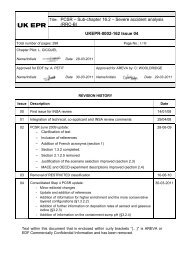Jetty Non Technical Summary - EDF Hinkley Point
Jetty Non Technical Summary - EDF Hinkley Point
Jetty Non Technical Summary - EDF Hinkley Point
You also want an ePaper? Increase the reach of your titles
YUMPU automatically turns print PDFs into web optimized ePapers that Google loves.
Mitigation<br />
6.3.8 In this EIA, those impacts assessed as being of potentially greater than minor adverse<br />
significance (i.e. impacts of moderate and major adverse significance) are the focus of<br />
mitigation, although every attempt has been taken to avoid, reduce and mitigate impacts<br />
through design change and adoption of best practice.<br />
6.3.9 The preferred hierarchy of mitigation is prevention first, then minimisation and, only as a<br />
last resort, compensation or remediation. The definitions of these are as follows:<br />
• prevention: avoid, relocate, modify the design and / or do not carry out the<br />
development;<br />
• reduction: introduce screens / blinds, modify design, alter technology, reduce size<br />
and scale of development etc; and<br />
• compensation or remediation: compensation to provide like-for-like replacement for<br />
any lost environmental elements (e.g. open green spaces, public facilities, wildlife<br />
area etc).<br />
6.3.10 Where possible, mitigation has been built into the jetty development (e.g. through the<br />
options chosen and through its design) and may be accepted, offset by other benefits of<br />
the jetty development or managed by the imposition of conditions within the HEO and/or<br />
on any licences granted.<br />
Residual Impacts<br />
6.3.11 The final step in the EIA process is the assessment of the residual impacts (i.e. those<br />
impacts remaining after the implementation (where necessary) of the proposed mitigation<br />
measures). Residual impacts are rated in accordance with the definitions of significance<br />
provided above. In this EIA, residual impacts assessed as minor or negligible are<br />
considered to be insignificant. More significant impacts may be accepted, offset by other<br />
benefits of the jetty development, or managed by the imposition of conditions within the<br />
HEO and / or on any licences granted.<br />
Cumulative Effects Assessment<br />
6.3.12 Cumulative effects are the additive and interactive effects that can arise from the jetty<br />
development cumulatively with other plans and projects. The EIA considers the jetty<br />
development cumulatively with the site preparation works, the <strong>Hinkley</strong> <strong>Point</strong> C Project,<br />
and other plans and projects which overlap in time and space (as regards those<br />
receptors that potentially could be affected).<br />
6.4 Consideration of Alternatives<br />
6.4.1 In accordance with the EIA Directive, an ES should outline the main alternatives<br />
considered by the applicant and present the main reasons for selecting the application<br />
site and design.<br />
No Development Alternative<br />
6.4.2 Proposed as Preliminary Works, the jetty development would allow <strong>EDF</strong> Energy to meet<br />
the target date of 2018 for the start of nuclear power generation by enabling the<br />
construction of <strong>Hinkley</strong> <strong>Point</strong> C to begin as early as possible after grant of the DCO. The<br />
2018 target is clearly set out in the draft National Policy Statements related to energy and<br />
<strong>Hinkley</strong> <strong>Point</strong> C Preliminary Works<br />
<strong>Non</strong> <strong>Technical</strong> <strong>Summary</strong><br />
Temporary <strong>Jetty</strong> Development 12 November 2010














![6.3 - Safety Injection System (RIS [SIS]) - EDF Hinkley Point](https://img.yumpu.com/42739985/1/184x260/63-safety-injection-system-ris-sis-edf-hinkley-point.jpg?quality=85)


